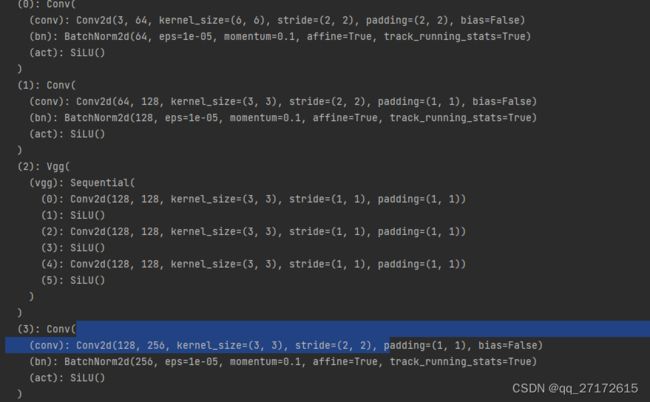yolo模型解析方法parse_model
目录
代码:
创建一个yaml加载方法
测试
模型修改:
一:backbone加一层卷积
二:head加一个上采样层
模型修改2:
使用vgg块:
代码:
def parse_model(d, ch): # model_dict, input_channels(3)
# Parse a YOLOv5 model.yaml dictionary
LOGGER.info(f"\n{'':>3}{'from':>18}{'n':>3}{'params':>10} {'module':<40}{'arguments':<30}")
anchors, nc, gd, gw, act = d['anchors'], d['nc'], d['depth_multiple'], d['width_multiple'], d.get('activation')
if act:
Conv.default_act = eval(act) # redefine default activation, i.e. Conv.default_act = nn.SiLU()
LOGGER.info(f"{colorstr('activation:')} {act}") # print
na = (len(anchors[0]) // 2) if isinstance(anchors, list) else anchors # number of anchors
no = na * (nc + 5) # number of outputs = anchors * (classes + 5)
layers, save, c2 = [], [], ch[-1] # layers, savelist, ch out
for i, (f, n, m, args) in enumerate(d['backbone'] + d['head']): # from, number, module, args
m = eval(m) if isinstance(m, str) else m # eval strings
for j, a in enumerate(args):
with contextlib.suppress(NameError):
args[j] = eval(a) if isinstance(a, str) else a # eval strings
n = n_ = max(round(n * gd), 1) if n > 1 else n # depth gain
if m in {
Conv, GhostConv, Bottleneck, GhostBottleneck, SPP, SPPF, DWConv, MixConv2d, Focus, CrossConv,
BottleneckCSP, C3, C3TR, C3SPP, C3Ghost, nn.ConvTranspose2d, DWConvTranspose2d, C3x}:
c1, c2 = ch[f], args[0]
if c2 != no: # if not output
c2 = make_divisible(c2 * gw, 8)
args = [c1, c2, *args[1:]]
if m in {BottleneckCSP, C3, C3TR, C3Ghost, C3x}:
args.insert(2, n) # number of repeats
n = 1
elif m is nn.BatchNorm2d:
args = [ch[f]]
elif m is Concat:
c2 = sum(ch[x] for x in f)
# TODO: channel, gw, gd
elif m in {Detect, Segment}:
args.append([ch[x] for x in f])
if isinstance(args[1], int): # number of anchors
args[1] = [list(range(args[1] * 2))] * len(f)
if m is Segment:
args[3] = make_divisible(args[3] * gw, 8)
elif m is Contract:
c2 = ch[f] * args[0] ** 2
elif m is Expand:
c2 = ch[f] // args[0] ** 2
else:
c2 = ch[f]
m_ = nn.Sequential(*(m(*args) for _ in range(n))) if n > 1 else m(*args) # module
t = str(m)[8:-2].replace('__main__.', '') # module type
np = sum(x.numel() for x in m_.parameters()) # number params
m_.i, m_.f, m_.type, m_.np = i, f, t, np # attach index, 'from' index, type, number params
LOGGER.info(f'{i:>3}{str(f):>18}{n_:>3}{np:10.0f} {t:<40}{str(args):<30}') # print
save.extend(x % i for x in ([f] if isinstance(f, int) else f) if x != -1) # append to savelist
layers.append(m_)
if i == 0:
ch = []
ch.append(c2)
return nn.Sequential(*layers), sorted(save)创建一个yaml加载方法
def load_yaml(path):
if isinstance(path, dict):
yaml = path
else:
import yaml
yaml_file_name = Path(path).name
with open(path, encoding='utf-8', errors='ignore') as f:
yaml = yaml.safe_load(f)
return yaml, yaml_file_name测试
modelDict, f = load_yaml(opt.cfg)
i, i1 = parse_model(modelDict, [3])
print(i)模型修改:
一:backbone加一层卷积
执行打印之后:
可以看到新加的模型被添加进去了:至于输出为什么1024 不是2048. 这里受宽度参数调节的
width_multiple: 0.5
二:head加一个上采样层
head:
[[-1, 1, Conv, [1024, 1, 1]],
[-1, 1, nn.Upsample, [None, 2, 'nearest']],
[[-1, 8], 1, Concat, [1]], # cat backbone P5
[-1, 3, C3, [1024, False]], # 15
[-1, 1, Conv, [512, 1, 1]],
[-1, 1, nn.Upsample, [None, 2, 'nearest']],
[[-1, 6], 1, Concat, [1]], # cat backbone P4
[-1, 3, C3, [512, False]], # 19 (P3/8-small)
[ -1, 1, Conv, [ 256, 1, 1 ] ],
[ -1, 1, nn.Upsample, [ None, 2, 'nearest' ] ],
[ [ -1, 4 ], 1, Concat, [ 1 ] ], # cat backbone P3
[ -1, 3, C3, [ 256, False ] ], # 23 (P3/8-small) 感受野最大 预测小物体
[-1, 1, Conv, [256, 3, 2]],
[[-1, 20], 1, Concat, [1]], # cat head P4
[-1, 3, C3, [512, False]], # 26 (P4/16-medium)
[-1, 1, Conv, [512, 3, 2]],
[[-1, 16], 1, Concat, [1]], # cat head P5
[-1, 3, C3, [1024, False]], # 29 (P5/32-large)
[ -1, 1, Conv, [ 1024, 3, 2 ] ],
[ [ -1, 12 ], 1, Concat, [ 1 ] ], # cat head P5
[ -1, 3, C3, [ 2048, False ] ], # 32 (P5/32-large)
[[23, 26, 29, 32], 1, Detect, [nc, anchors]], # Detect(P3, P4, P5)测试
device = select_device(opt.device)
im = torch.rand(opt.batch_size, 3, 640, 640).to(device)
m = Model(opt.cfg)
model = Model(opt.cfg).to(device)
r = model(im, profile=True)输出结果
模型修改2:
使用vgg块:
1:定义一个vgg块:
class Vgg(nn.Module):
def __init__(self, in_channels, out_channels, num_convs=2):
super().__init__()
layers = []
for _ in range(num_convs):
layers.append(nn.Conv2d(in_channels, out_channels, kernel_size=3, padding=1))
layers.append(nn.SiLU())
in_channels = out_channels
self.vgg = nn.Sequential(*layers)
def forward(self, x):
return self.vgg(x)2 : parse_model函数 如下添加
if m in {
Conv, GhostConv, Bottleneck, GhostBottleneck, SPP, SPPF, DWConv, MixConv2d, Focus, CrossConv,
BottleneckCSP, C3, C3TR, C3SPP, C3Ghost, nn.ConvTranspose2d, DWConvTranspose2d, C3x, Vgg}: if m in {BottleneckCSP, C3, C3TR, C3Ghost, C3x, Vgg}:3:修改yaml
backbone:
# [from, number, module, args [输出, 核大小, 步长, 填充]]
[[-1, 1, Conv, [64, 6, 2, 2]], # 0-P1/2
[-1, 1, Conv, [128, 3, 2]], # 1-P2/4
[-1, 3, Vgg, [128]],
[-1, 1, Conv, [256, 3, 2]], # 3-P3/8
[-1, 6, C3, [256]],
[-1, 1, Conv, [512, 3, 2]], # 5-P4/16
[-1, 9, C3, [512]],
[-1, 1, Conv, [1024, 3, 2]], # 7-P5/32
[-1, 3, C3, [1024]],
[ -1, 1, Conv, [ 2048, 3, 2 ] ], # 9-P6/64
[ -1, 3, C3, [ 2048 ] ],
[-1, 1, SPPF, [2048, 5]], # 11
]结果:




